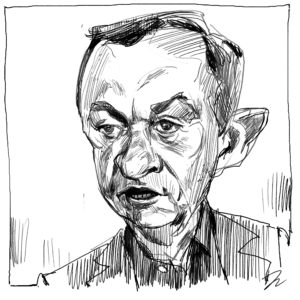Whatever happened to RIP?
spiked editor Mick Hume in The Times (London), on society's unhealthy obsession with dead bodies.

Want to read spiked ad-free? Become a spiked supporter.
Headlines scream of ‘horror’ at the ‘evil’ done in Hillingdon Hospital mortuary. The local Labour MP says that his constituents have been ‘traumatised’. The police and hospital offer a Pounds 5,000 reward, vowing that they ‘will not rest’ until the perpetrators of these ‘appalling crimes’ are brought to justice.
What atrocity has occurred? Rashers of bacon were found on the body of a 65-year-old Muslim woman in January. After a major investigation, Scotland Yard announced that a white woman’s body had also been marked with a pen in 1996, and that they have found 2,000 photos of corpses, taken over the past decade, at the home of a mortuary worker.
At the risk of seeming insensitive, the official response looks like an hysterical overreaction to the manhandling of some dead bodies. It is not hard to think of living, breathing people who can only dream of the health authorities, police or MPs showing such a passionate interest in their problems.
No doubt all sorts go on behind closed mortuary doors. The revelation that ‘Weirdos work in morgue’ should have as little news value as the proverbial ‘Dog bites man’ story. But the goings-on at the Hillingdon mortuary have sparked a public scandal by bringing together two morbid symptoms of our anxious age: the exaggerated fear of ‘Islamophobia’ and the unhealthy obsession with the welfare of dead bodies.
It is understandable that the family of the Muslim woman should be upset by what they see as the desecration of her body with bacon (Islam forbids touching pig meat). What is sick is the way that the family’s hurt has been politicised by campaigners scratching around for evidence of Islamophobia.
A spokeswoman for the Muslim Council of Britain said the case was ‘like 1930s Germany’, a comparison which rather missed the point that the Nazis treated people like pieces of meat while still alive. Imran Khan, the family’s solicitor and veteran of the Stephen Lawrence campaign, reportedly described the bacon incident as ‘the worst example of anti-Muslim feeling he has ever seen’, which inadvertently suggests that there cannot be that many bad examples of anti Muslim feeling to see. The major police operation launched in response to this bizarre one-off incident, involving both the Racial and Violent Crime Task Force and the Community Safety Unit, confirms that fear of Islamophobia today is considerably stronger than the phenomenon itself.
The wider interest in the horror stories about Hillingdon reflects our obsession with corpses. Dead bodies have never been such a live issue in Britain. The nutter who took those 2,000 pictures in the mortuary looks almost normal in today’s culture.
Everywhere you look, controversies about the treatment of corpses pop up out of the ground like the zombies in Night of the Living Dead. Should hospitals be permitted to retain organs for medical research? Should the BBC show pictures of dead British soldiers? Should the Channel 4 import Six Feet Under, a hit show about, errm, undertakers, be banned from using mocked-up corpses in poster adverts?
Millions have flocked to see Body Worlds, Professor Gunther Hagens’ controversial exhibition of plastinated and dissected corpses, and his televised ‘live’ autopsy. Labour proposes to create a specific offence of ‘sexual interference with human remains’, despite conceding that such deviant behaviour is ‘extremely rare’. No wonder a couple of perverts interfering with corpses can be treated as a tragedy that traumatises the public.
Concern with the treatment of the dead is often articulated in religious terms. Yet both the Christian and Islamic traditions essentially treat the body as a husk, from which the soul departs upon death. The cult of the corpse has more modern origins. In our selfobsessed, conviction-lite society, the body itself has become the last refuge of many people’s identity, a powerful trend expressed, for example, in the obsessive promotion of health and exercise regimes. It seems that the quest for perfection of the body in life is now accompanied by a morbid preoccupation with maintaining the integrity of the corpse. So a strange little case of interfering with dead bodies can cause more fuss than most actual murders.
In the wake of the ‘body parts scandal’, it is ever more difficult to obtain organs and tissue for research or transplant. The real scandal is that sick people are being sacrificed to the cult of the corpse.
Now the authorities are considering informing the relatives of those whose bodies were photographed in the Hillingdon mortuary over the past decade. Who will benefit from this institutionalised mawkishness? Do we really want to open the mortuary doors to public inspection? Never mind this cacophony of outrage – what’s wrong with ‘as silent as the morgue’?
This article is republished from The Times (London)
Who funds spiked? You do
We are funded by you. And in this era of cancel culture and advertiser boycotts, we rely on your donations more than ever. Seventy per cent of our revenue comes from our readers’ donations – the vast majority giving just £5 per month. If you make a regular donation – of £5 a month or £50 a year – you can become a and enjoy:
–Ad-free reading
–Exclusive events
–Access to our comments section
It’s the best way to keep spiked going – and growing. Thank you!










Comments
Want to join the conversation?
Only spiked supporters and patrons, who donate regularly to us, can comment on our articles.